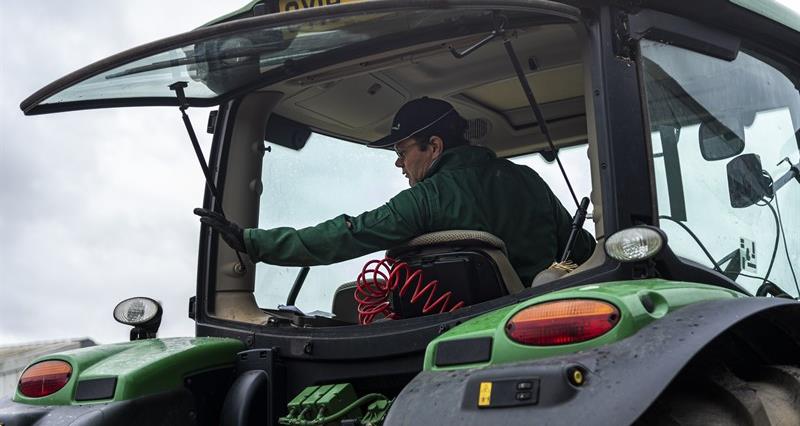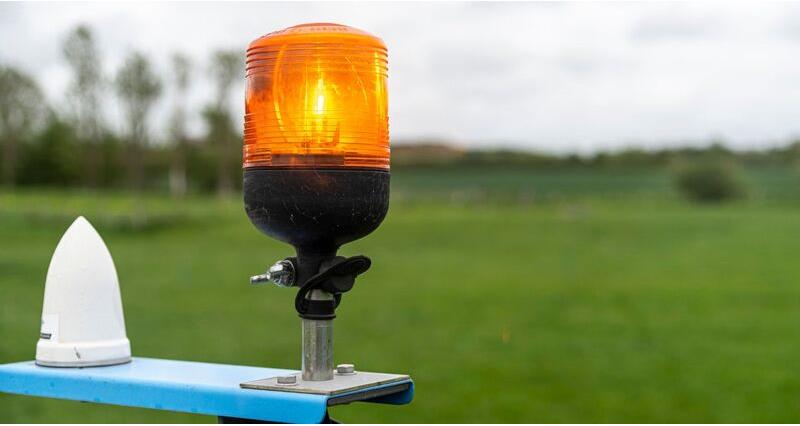Lighting requirements on the road
- All agricultural motor vehicles must be fitted with two red lamps to the rear and two white lamps to the front.
- If you have lights fitted, even if they are not required, they must be clean, un-obscured and maintained in good working order (even in the daylight).
- If you are driving after dark, you must have lights switched on and working.
- If headlamps are fitted, they must be lit during daylight hours if the visibility becomes adverse due to fading light or poor weather.
- Never display any white light to the rear (e.g. work lights) these can dazzle other motorists and it is an offence, unless the vehicle is using reversing lights whilst travelling backwards.
- Using work lights at the front of the vehicle can dazzle other motorists even when they are pointed down as they are in such a high position; it is also an offence because they are in the wrong position for road use.
- If equipment covers the lights i.e. mounted or trailed equipment, then extra lights must be fitted to the equipment.
Tractors lights
Tractors should have:
- Two white front side-lights
- A number plate light
- Two red tail lights
- Tow red rear reflectors
Vehicles built after 1986 and which travel over 15mph require dipped headlights, indicators and hazard warning lights.
Vehicles built after 1986 and which travel over 25mph need two red stop lamps.
Fast Tractors
Higher specification tractors known as Fast Tractors are permitted to travel at a maximum speed of 40mph. Such tractors are built to a higher construction specification including front and rear axle suspension and a braking efficiency of at least 50%.
They must have brake lamps, dipped beam headlamps, main beam headlamps, direction indicators, hazard warning signals and rear fog lamps.
Lamps and reflectors
There are also regulations covering the height of the lamps and reflectors from the ground, the distance from the side of the vehicle, separation distances and dimensions of lamps.
These will normally have been taken into consideration by the tractor manufacturer, but if you are unsure or you have modified the vehicle in some way or you need to fit lights to compensate for covered or obscured lights on the towing vehicle you can call NFU CallFirst on 0370 845 8458.
Amber beacons
Amber beacons are required on any vehicle and trailers if they cannot exceed 25mph and are driven on an unrestricted dual carriageway.
Beacons must be capable of emitting a flashing or rotating beam of light throughout 360 degrees and every warning beacon must be fitted so that the centre of the lamp is not less than 1.2m above the ground.
The light shown by the beacon must be visible from any point at a reasonable distance from the vehicle or trailer drawn by it. This means it must be visible from the front, back and sides of a tractor or trailer.
Under no circumstances must a unidirectional light be fitted that could be mistaken for an indicator light.
Trailer lights
Trailers need to have red rear position lights (tail lights), they should also have two red rear reflectors and a number plate light.
The trailer should also have indicator lights unless the trailer was built before 1 October 1990.
There isn't a requirement to have stop lamps (brake lights) fitted on trailers but these should be fitted if obligatory stop lamps on the tractor are obscured.
It is strongly recommended to have stop lamps and indicators fitted to the trailer and have them working regardless of the legal requirements. There are many accidents each year with drivers overtaking tractors failing to indicate when a trailer is about to turn right.
The trailer should have front position lights fitted if the trailer is more than 1.6 metres wide or is less than 2.3 metres in length and first used before 1 October 1985.
If the trailer is more than 5 metres long you should have side retro reflectors every 3 metres.
Parking on the road in darkness
Motor vehicles should not be left standing on the road at any time between sunset and sunrise unless:
- the nearside of the vehicle is as close as possible to the edge of the carriageway
- permission has been obtained from a police officer
- the vehicle is being used in the repair of another vehicle
- the road is a one-way street
- the vehicle is standing in a designated parking or stopping area
Tractors and trailers must face the direction of the flow of traffic and all obligatory lights (including front and rear position lamps and rear registration lamp) have to be lit when parked between sunset and sunrise. If the trailers are parked without the tractor they must have front and rear position lamps fitted and lit at all times between the hours of sunset and sunrise.

